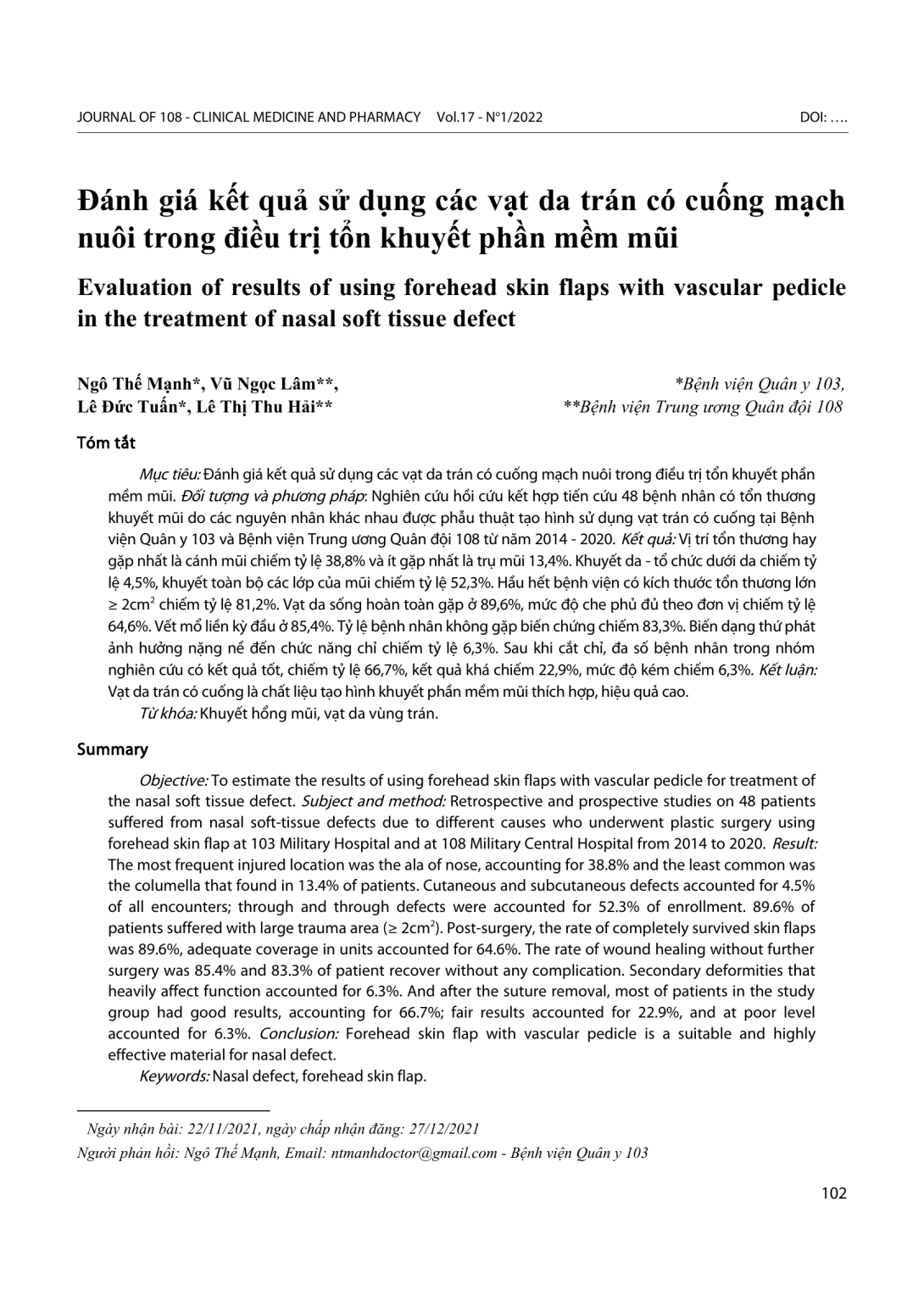
Đánh giá kết quả sử dụng các vạt da trán có cuống mạch nuôi trong điều trị tổn khuyết phần mềm mũi. Đối tượng và phương pháp: Nghiên cứu hồi cứu kết hợp tiến cứu 48 bệnh nhân có tổn thương khuyết mũi do các nguyên nhân khác nhau được phẫu thuật tạo hình sử dụng vạt trán có cuống tại Bệnh viện Quân y 103 và Bệnh viện Trung ương Quân đội 108 từ năm 2014 - 2020. Kết quả: Vị trí tổn thương hay gặp nhất là cánh mũi chiếm tỷ lệ 38,8% và ít gặp nhất là trụ mũi 13,4%. Khuyết da - tổ chức dưới da chiếm tỷ lệ 4,5%, khuyết toàn bộ các lớp của mũi chiếm tỷ lệ 52,3%. Hầu hết bệnh viện có kích thước tổn thương lớn ≥ 2cm2 chiếm tỷ lệ 81,2%. Vạt da sống hoàn toàn gặp ở 89,6%, mức độ che phủ đủ theo đơn vị chiếm tỷ lệ 64,6%. Vết mổ liền kỳ đầu ở 85,4%. Tỷ lệ bệnh nhân không gặp biến chứng chiếm 83,3%. Biến dạng thứ phát ảnh hưởng nặng nề đến chức năng chỉ chiếm tỷ lệ 6,3%. Sau khi cắt chỉ, đa số bệnh nhân trong nhóm nghiên cứu có kết quả tốt, chiếm tỷ lệ 66,7%, kết quả khá chiếm 22,9%, mức độ kém chiếm 6,3%. Kết luận: Vạt da trán có cuống là chất liệu tạo hình khuyết phần mềm mũi thích hợp, hiệu quả cao.
To estimate the results of using forehead skin flaps with vascular pedicle for treatment of the nasal soft tissue defect. Subject and method: Retrospective and prospective studies on 48 patients suffered from nasal soft-tissue defects due to different causes who underwent plastic surgery using forehead skin flap at 103 Military Hospital and at 108 Military Central Hospital from 2014 to 2020. Result: The most frequent injured location was the ala of nose, accounting for 38.8% and the least common was the columella that found in 13.4% of patients. Cutaneous and subcutaneous defects accounted for 4.5% of all encounters; through and through defects were accounted for 52.3% of enrollment. 89.6% of patients suffered with large trauma area (≥ 2cm2). Post-surgery, the rate of completely survived skin flaps was 89.6%, adequate coverage in units accounted for 64.6%. The rate of wound healing without further surgery was 85.4% and 83.3% of patient recover without any complication. Secondary deformities that heavily affect function accounted for 6.3%. And after the suture removal, most of patients in the study group had good results, accounting for 66.7%; fair results accounted for 22.9%, and at poor level accounted for 6.3%. Conclusion: Forehead skin flap with vascular pedicle is a suitable and highly effective material for nasal defect.
- Đăng nhập để gửi ý kiến
